Description
Manager of the Larzac site: Cédric Champollion
The Durzon site is located on a karstic aquifer with an area of 100 km2 which supplies the Durzon Spring (average discharge 1.4 m3/s). This spring provides a natural supply of drinking water to the Aveyron portion of Larzac. The site is equipped to monitor the discharge from the spring (Grands Causses Nature Park). The Montpellier Geoscience Laboratory provides rainfall monitoring, measurements of underground flows, tiltmeter measurements of the deformations associated with recharge, and surface and underground gravity measurements of selected sites. Additional hydrological and geochemical monitoring are provided by the Montpellier Hydrosciences laboratory. The main scientific issue concerns the dynamics of the transport and storage of water, mainly in the unsaturated zone.
Scientific goals
The Larzac karst is located in the Grands Causses region, in the southern Massif Central. The aquifer in question is located in limestone and dolomite formations of the Middle and Upper Jurassic, some 400 m thick. These formations overlie the marly Upper Lias series, 200 m in thickness (Bruxelles, 2001a). This sedimentary horizon acts as an impermeable barrier and defines the saturated limit of the karstic system. The monoclinal regional structure is cut by E-W thrusts of Pyrenean age, which uplift the impermeable Lias marls towards the north. The Neogene and Plio-Quaternary uplift led to down-cutting in the plateau and the creation of canyons (Ambert and Ambert, 1995), thereby facilitating karstification, given the hydraulic head gradient between the recharge (plateau) and discharge (canyon) zones. Recharge from rainfall infiltrates on the surface of the plateau (750 m), while discharge takes place at the Durzon Spring (530 m). The average discharge measured at this Vauclusian-type spring is 1.4 m3/s, but it varies from 0.8 to 18 m3/s. Tracing experiments, geomorphologic observations, and mass balances have produced estimates of 100 km2 for the recharge area (Ricard and Bakalowicz, 1996). During certain exceptional rainstorms temporary lakes form in the southern recharge zone (Bruxelles, 2001a), suggesting that the unsaturated zone (epikarst and infiltration area) cannot have the same hydraulic properties on its south and north sides (Bruxelles, 2001b; Ricard and Bakalowicz, 1996).
The principal scientific objectives of the experiments and monitoring carried out are as follows:
The overall goal of the project is to gain a better understanding of the processes which control the spatial and temporal variations in the supply of water in karstic environments, by in situ observation of the hydrologic, geophysical, and geodesic parameters associated with water flows within the karst. The following points in particular will be investigated:
- The respective roles played by the unsaturated zone (epikarst and infiltration zone) and the submerged zone. We propose to make a particular study of the epikarst, for which research has demonstrated a significant contribution over several seasonal and interannual cycles.
- Water infiltrates the unsaturated zone in a multi-modal fashion, including slow diffusion in the porous media, and more or less rapid travel in microfissures and cracks. We would like to characterize the respective contributions of the various modes of transport in terms of characteristic variations in water mass and travel time.
- A multidisciplinary approach to the epikarst and the infiltration zone based on structural, petrophysical, and hydraulic studies of these units. The project employs the additional tools of geodesy (gravimetry and tiltmetry), and geophysics (electrical, seismic, and proton resonance techniques) both on surface and in boreholes, and also hydrogeology. It also applies in situ geodesic and hydrogeologic observation tools.
- Investigations of the highly heterogeneous karstic environment raise the problem of the changing scale of our observations. We are currently installing a “local” experimental site where integrative methods of investigation, such as gravimetry, will be compared against geophysical observations made on surface and in boreholes.
- On a larger scale, the Larzac karst constitutes a system whose limiting hydraulic conditions are well known. We will offer an overall circulation model combining the various modes of transport and the observations made at different scales, particularly the spatio-temporal variations of gravity at the regional scale.
Monitoring and principal experiments conducted on the site
The Larzac Karstic “Observatory” came to prominence in 2006 with the initiation of the ANR ECCO PNRH Project entitled “Hydrology and Geodesy” by Montpellier Geosciences and Montpellier Hydrosciences and was continued with the ANR HydroKarstG² between 2009 and 2012. This involved the installation of gravimetric and tiltmetric observation sites for investigating spatio-temporal variations in water storage and the associated sub-surface deformation This instrumentation was supplemented by other geodesic (GPS), meteorologic, and hydrogeologic tools, designed to make local determinations of 1) vertical ground movements; 2) the spatio-temporal distribution of rainfall on the karst; 3) variations in the depth of the submerged zone; and 4) the temporal characteristics of water flow in the infiltration zone.
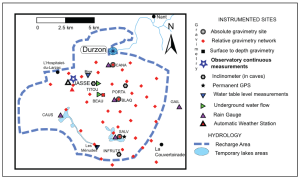
Repeated observations
- 3 sites (CANA, BLAQ, SALV) measured for absolute gravity (FGS 228, Géosciences Montpellier Parc Gmob/DT/INSU) with a frequency of measurement of less than 2 months
- 1 site (BEAU) for differential vertical gravity measurements on a six-monthly cycle (CG5, Parc Gmob/DT/INSU)
- 1 High-Precision Gravimetric Network (RGHP) with 40 stations, repeated on a six-monthly cycle (CG5, Parc Gmob/DT/INSU, A10, IGN/IPGP/IRD)
Continuous observations
- 3 tiltmeter couples (PORTA, TITOU, INFRUTS) measured with hydrostatic-type tiltmeters (Geosciences Montpellier)
- A hydrogeophysical observatory (gravimetry, electrical tomography, evapotranspiration, GPS, seismometer)
- 5 rainfall gauges, supplemented by the rainfall gauge at La Cavalerie
- 2 GPS station (RENAG) combined with a meteorological station (pressure, temperature, & humidity) (SALV and JASSE)
- 2 flowmeters (TITOU, BEAUMELLES) measuring water flow (stalactites)
- 4 pressure sensors, in a borehole (-40 m, LES MENUDES and -20-50m at JASSE)
- 1 water-stage recorder (-150 m, LA BISE)
- 1 water-stage recorder at the Durzon Spring for measuring the spring’s discharge (Grands Causses Regional Nature Park)
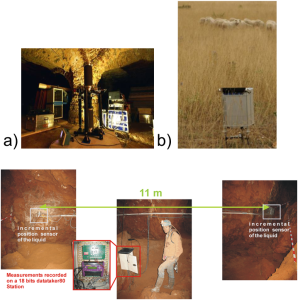
Comments: the gravimetric observations were obtained using instruments from the national mobile gravimetric inventory: Gmob (DT/INSU). The absolute gravimetry sites of the “Larzac Observatory” are integrated online with the Montpellier-Mont Aigoual Observatory’s national gravimetric database, which enables relative calibration of the gravimeters of national and foreign institutes.
On the technologic level, the observatory produces inter-comparisons of the various relative and absolute gravimetric instruments (see scheduled experiments). A major program is currently under way in the areas of teletransmission of information (GSM for the GPS station, and in the near future for the tiltmeters) and the design of tiltmeters (”Laser Interferometry for Strength (LINES))”: an interferometric measurement project submitted to ANR RISKNAT 2008. The Salvetat (SALV) and JASSE GPS stations is a part of the RENAG (INSU/CNRS) network.
Advanced projects
Spatio-temporal variations in the water supply in the Larzac karstic system
From 2006 to 2008 the absolute gravity was regularly measured using the FG5 gravimeter at three sites located on the Larzac karstic system, to quantify variations in the water supply. In parallel with this the gravity was measured each month at Montpellier; these observations contribute to a better understanding of the continental water cycle. In addition, they were compared with satellite gravity observations of the GRACE and GOCE type, and ground measurements (Global Geodynamic Project), for comparison with climatic models.

The absolute observations were supplemented in 2007-2009 by regular reoccupations of the stations (2-3 times per year) in a 45-site gravimetric network, using relative gravimeters of CG5 type (INSU instrument inventory). The observations record spatio-temporal variations in the water supply beneath the karst, particularly over the course of the seasonal and interannual cycles. The figure below illustrates the changes in gravity between April and October 2008.
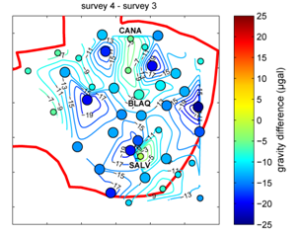
The year 2010 was devoted to spatio-temporal measurements of the water supply in the Larzac karstic system
- Continuation of FG5 absolute gravity measurements (8 per year) on the La Salvetat and Montpellier sites
- Repetition of the relative gravity profile: La Salvetat – Les Menudes
- Following Surface to Depth measurements carried out previously at the Beaumelle sinkhole (Jacob et al. 2009), similar measurements (gravity measurements on surface and at depth using the Scintrex CGS) were begun on two new sites: the Besses and Séoubio sinkholes. The significance of these new measurements lies in the changes in the water content of the unsaturated zone in three different karstic settings (dolomite, limestone, and epikarst). These measurements are repeated two to three times a year.
Installation of the GEK Observatory – La Jasse Site
Phase 1 – Geophysical characterization of the site
In order to select the optimum place for installing the iGrav superconducting gravity meter (January 2011), a number of geophysical tools were deployed to characterize the La Jasse site: micro-gravimetric mapping of the site (40 points), surface and underground seismic reflection, electrical pseudo-sections, surface and underground tomography, and two RMP measurement campaigns (in the wet and dry seasons)
Phase 2 – Installation of the Larzac “GEK Gravimetric Observatory”
Agreement with partner organizations: SCTL and the commune of Hospitalet; Building design; Electrification of site and construction of building. Installation of instruments and regular acquisition/treatement of the data.
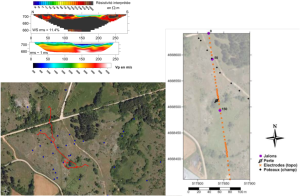
Tiltmeter observations
Since July 2006 we have been acquiring tiltmeter measurements on the Larzac plateau. Three stations have now been installed, the most recent, at the Portalerie sinkhole, has been operating since mid-April 2009; the Titou and Portalerie stations are a few km south of the Durzon Spring, and the Infruts station is located much farther south in the vicinity of the Plateau’s temporary lakes. With financing from OSU OREME and H+, the three stations have been made electrically autonomous by the installation of solar panels. We are currently working on the transmission of data by satellite, to achieve direct control of all the stations from Geosciences Montpellier.
The first two stations at Infruts and Titou have shown that after each rainfall event they record tiltmeter deformations, which we see as pressure changes in the karst fractures (Jacob et al., submitted). We have also demonstrated, at the Titou and Infruts stations, that the direction of the deformation’s maximum slope was oriented mainly between N 30° E and N 60° E (Jacob et al., 2009, submitted).
At the most recent station, Portalerie, we observed tiltmeter deformations throughout all of the rainfall events during the spring of 2009. When we calculate the maximum associated slope direction, it falls more or less in the same direction as at the two previous stations (Infruts and Titou): N 45° E to N 50° E. The amplitudes observed at Portalerie for 2010 are smaller than at Titou or Infruts.

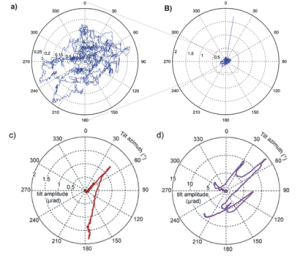
These four figures present the polar diagrams for the three tiltmeter stations of Portalerie, Titou, and Infruts. These diagrams show the direction of the gradient of maximum deformation over time.
Measurements of underground flows
Since 2006 we have been making measurements, at four surface locations and two underground ones, of the water flows on the Durzon site. These measurements, performed with rain gauges and water-level sensors, are essential because they enable estimates of the water loads responsible for the gravimetric and tiltmeter variations that we measure.
In future, above-ground rainfall measurements will be carried out on three sites: La Salvetat, La Jasse, and Les Menudes. Underground measurements will be supplemented by a pressure sensor, to assist in understanding the observed variations in discharge (the high-frequency component at one of the sites is correlated with variations in atmospheric pressure).
The two underground discharge sites at the Titou and Besses sinkholes are now in reliable operation. The Besses Sinkhole required the manufacture of a rain gauge with a special trough capable of containing large discharges. Measurement of these discharges since the spring has produced a classic diminishing curve, on which a complex signal is superimposed. Deconvolution of the signal and its analysis may enable the construction of an operating model for the catchment drained by this flow.


Joint programs and participating researchers
We hope that the Durzon Site will eventually become an infrastructure resource capable of hosting a variety of national and international projects on themes related to the geophysical, geodesic, and hydrologic observation of karst.
Application of the acquired data
The data acquired up to 2009 have been the subject of two thesis (by T. Jacob and S. Deville). A new thesis is in progress (B. Fores) on fine temporal and spatial variations varitations high frequency stock and transfer of water from the surface to the embedded area.
Short- and medium-term Programming
- Interpretation of superconducting gravity meter data at the La Jasse Observatory (2013-present)
- Development of local modeling of flows in an unsaturated heterogeneous medium (2012-present)
- Installation of a flow tower for measuring evapotranspiration (2012-present)
- Development of spatial modeling of flows at the scale of the aquifer (2014) constrained by observations at the catchment scale (gravimetry, electrical tomography, EM)
- Caracterization of the water transfert using geophysical methods
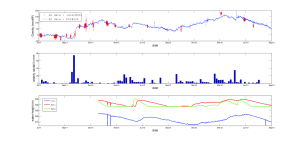
Data availability
Main datasets
In this OSURIS catalog you can find links to key datasets of the site together with metadata:
Water cycle: https://www.osuris.fr/metadata/SNO-HPLUS-LARZAC-WATER-CYCLE
Geodesy: https://www.osuris.fr/metadata/SNO-HPLUS-LARZAC-GEODESY
Borehole hydrogeophysics: https://www.osuris.fr/metadata/SNO-HPLUS-LARZAC-BOREHOLE-HYDROGEOPHYSICS
All datasets
To help finding general datasets, predefined database requests have been created and are regularly executed. Results of the requests can be downloaded from the links available here:
Larzac
Water cycle
- Piezometry: 2012, 2013, 2014, 2015, 2016, 2017, 2018, 2019, 2020, 2021
- Flowrate measurements
- Rainfall
Borehole hydrogeophysics
- Normal electical resistivity
- Acoustic velocity
- Focus electrical resistivity
- Spectral radioactivity gamma
Spatialized hydrogeophysics
Geodesy
- All tiltmeter
- Tiltmeter (raw): 2006, 2007, 2008, 2009, 2010, 2011, 2012, 2013
- Tiltmeter (processed): 2006, 2007, 2008, 2009, 2010, 2011, 2012, 2013
- All gravimetry
- Gravimetry (raw): 2011, 2012, 2013, 2014, 2015, 2016, 2017, 2018, 2019, 2020, 2021
- Gravimetry (relative): CG5_445, CG5_167
Boreholes
Stations
KMZ viewer
The viewer below offers a comprehensive site visualization and information on available public data such as types, numbers and dates of measurements, locations of sites, wells and stations, as well as data providers information. This interface also provides an overview of available geophysical maps and cross-sections.
To visualize all data in the Google Earth software, you can download the following KMZ file: Larzac.kmz

